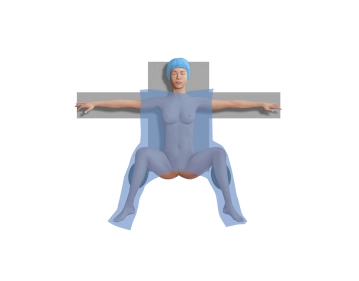Medical history
Is the prolapse only present during defecation and physical exercise or is it chronic?
Patients often complain of peranal bleeding, e.g. due to solitary rectal ulcer (benign; common in rectal prolapse; always located anteriad).
Is constipation or diarrhea present, possibly alternating?
Other complaints include the feeling of incomplete defecation (= repeated visits to the toilet with violent, frustrating attempts to strain), tenesmus and mucous discharge.
It almost always is complicated by fecal incontinence and impairs social life: For example, toilets must always be easy to reach, no meal before leaving home.
In women, there often are concomitant pelvic floor prolapse and urinary incontinence.
Basic proctologic work-up with inspection, palpation and proctorectoscopy
- Inspection/straining attempts: No matter how impressive advanced rectal prolapse may be: It is easily overlooked if it is only present during defecation and the patient avoids intense pressing during the examination out of shame, or - which is not uncommon - confuses straining with squeezing. Often the prolapse only becomes manifest after several attempts at straining. If needed, have the patient assume a squatting position or sit on a commode. Circular mucosal folds are characteristic of full-thickness rectal prolapse.
- Digital rectal examination: Active squeezing and relaxation allows a general assessment of the sphincter muscles. During straining, possible intussusception or rectocele may be palpated. Indurated mucosal areas: Might be suggestive of a solitary rectal ulcer.
- Proctoscopy: Often (but not always), intussusception becomes manifest by protrusion of the anterior rectal wall into the anal canal, when the proctoscope is retracted to the external end of the anal canal and the patient is asked to strain.
- Rectoscopy: May reveal a solitary rectal ulcer (always located anteriad).
Distal proctitis beginning at the anorectal junction and ending abruptly at 10-12 cm from the dentate line, is often accompanied by rectal prolapse.
Functional diagnostic work-up
Defecography can demonstrate the prolapse, but if the diagnosis is clear, this modality may be omitted.
- Conventional defecography
Conventional defecography allows assessment not only of rectal prolapse but also of abnormalities such as rectocele, intussusception and sigmoidocele. Since defecography diagnoses functional as well as morphological changes of the pelvic floor including the rectosigmoid - in case of oral contrast agents also enteroceles - this modality yields deep insight, especially in pelvic floor failure with the leading symptom " defecation disorder".
Due to the multifactorial etiology of pelvic floor failure, which usually involves several compartments and often combined disorders, dynamic imaging of all pelvic organs is crucial.
Changes in the central "gynecological" compartment and in the anterior "urological" compartment of the pelvic floor cannot be imaged. In the past, this was only possible indirectly by additional contrast of the accessible organs employing colpocystorectography, although the
exposure to radiation and the psychological stress of the study itself should not be neglected.
- Dynamic pelvic floor MRI:
In comparison to conventional defecography, dynamic MRI of the pelvic floor offers the opportunity to ensure total imaging of the pelvic floor and its organs, since the anterior, central and posterior compartments, as well as enteroceles, may be imaged without radiation exposure in a single scan. Dynamic pelvic floor MRI can simultaneously depict the anatomical position of all pelvic organs during breathing, straining and squeezing, both in highly representative single frames and cine mode.
Unlike conventional defecography, dynamic MRI of the pelvic floor (MR defecography) generally offers these mostly female patients the benefit of dynamic imaging of all compartments and organ systems with improved patient comfort.
The main benefit here is the absence of radiation exposure. Studies with the patient sitting or recumbent do not result in different findings. In general, however, the relevance of image morphology in dynamic MRI studies has not yet been fully established, as normal and pathological findings overlap.
- Endosonography is helpful whenever a sphincter defect is suspected.
- Other functional studies such as electromyograph and measurement of nerve conduction velocity are reserved for special cases.
Colonoscopy
Preoperative standard to study colorectal topography and rule out other pathology.


